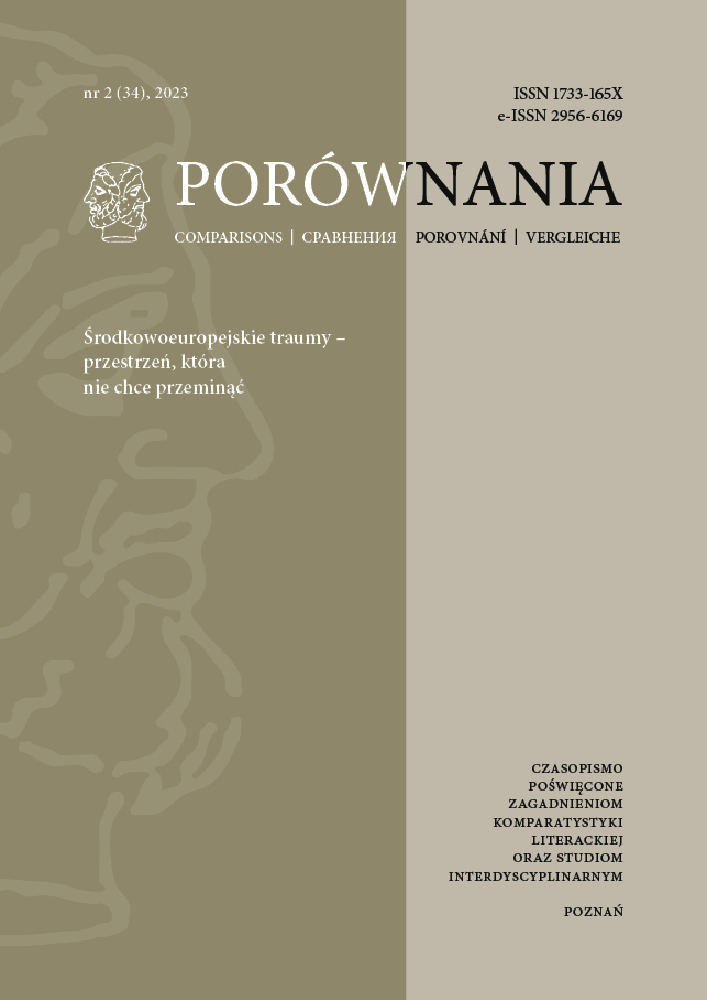Abstrakt
Repression and concealment of one of the worst traumatic experiences of the 20th century affects Europe’s largest minority in a massive way. In contrast to the Shoa, the Porajmos is little known to many people of both the majority and the minority. Often repressed as a taboo, breaking the silence about this trauma is of central relevance for the self-confidence of the Roma, especially those born afterwards. In fact, in the case of victims and their children and grandchildren, there is a tension between repression and concealment on the one hand and the need to overcome trauma on the other. Using the example of two educational works for young minority and majority readers in which the painful memories of Polish Romani Sofia Taikon, born Brzezinska, are fictionalised, the article illustrates how this tension is dealt with and how space is given to the long-tabooed trauma.
Bibliografia
“Ich musste mich öffnen, musste schreien.” Kleine Zeitung, 29 Jan. 2013, http://tinyurl.com/yss52uny. Accessed 20 August 2022.
Auzias, Claire. Samudaripen, le génocide des Tsiganes. Paris: L’esprit frappeur, 1999.
Bastian, Till. Sinti und Roma im Dritten Reich. Geschichte einer Verfolgung. München: Beck, 2001.
Bauer, Ullrich. “Shoah und Porajmos—Eine Relationale Perspektive.” Antisemitismus im 21. Jahrhundert: Virulenz einer alten Feindschaft in Zeiten von Islamismus und Terror. Eds. Marc Grimm and Bodo Kahmann. Berlin–Boston: De Gruyter Oldenbourg, 2018. 87–110. DOI: https://doi.org/10.1515/9783110537093-005
Brooks, Ethel. “The Possibilities of Romani Feminism.” Signs Journal of Women in Culture and Society 38.1 (2012): 1–11. DOI: https://doi.org/10.1086/665947
Central Council of German Sinti and Roma. European Holocaust Memorial Day for Sinti and Roma. Europäischer Holocaust-Gedenktag für Sinti und Roma. https://www.roma-sinti-holocaust-memorial-day.eu/de/. Accessed 20 August 2022.
Cohen, Jonathan M.D. “Trauma and repression.” Psychoanalytic Inquiry 5.1 (1985):163–189. DOI: https://doi.org/10.1080/07351698509533580
Danieli, Yael. Ed. International Handbook of Multigenerational Legacies of Trauma. New York: Plenum, 1998. DOI: https://doi.org/10.1007/978-1-4757-5567-1
Donert, Celia, and Eve Rosenhaft. The Legacies of the Romani Genocide in Europe since 1945. London: Routledge, 2022. DOI: https://doi.org/10.4324/9780429296604
Fings, Karola. “Opferkonkurrenzen. Debatten um den Völkermord an den Sinti und Roma und neue Forschungsperspektiven.” Shoah: Intervention. Methods. Documentation 2 (2015): 79–101.
Franz, Philomena. Zwischen Liebe und Hass: Ein Zigeunerleben. Freiburg: Herder, 1985.
Hancock, Ian. On the interpretation of a word: Porrajmos as Holocaust. The Romani Archives and Documentation Center—RADOC, 2006. http://tinyurl.com/yykxn3a4. Accessed 20 August 2022.
Hertrampf, Marina Ortrud M. “‘Porajmos-Comics’: Der Blick von Roma auf den Holocaust.” Selbst- und Fremdbilder von Roma in Comic und Graphic Novel. Vom Holocaust bis zur Gegenwart. Eds. Marina Ortrud M. Hertrampf, Kirsten von Hagen. München: AVM, 2020. 51–80.
Hirsch, Marianne. The Generation of Postmemory: Writing and Visual Culture After the Holocaust. New York: Columbia University Press, 2012.
Levi, Primo. Survival in Auschwitz. New York: Simon and Schuster, 1996.
Lundgren, Gunilla. “The blonde bandit Arthur Thesluff: Committed scholarship in early Romani studies and today.” Scholarship and the Gypsy-Struggle. Commitment in Romani Studies: A Collection of Papers and Poems to Celebrate Donald Kenrick’s Seventieth Year. Eds. Donald Kenrick and Thomas Alan Acton. Hatfield: University of Hertfordshire Press, 2000.129–139.
Matras, Yaron. “A conflict of paradigms: review article.” Romani Studies 14.2 (2004):193–219. DOI: https://doi.org/10.3828/rs.2004.7
Mohtadi, Lawen. Den dag jag blir fri. Stockholm: Kultur & Natur, 2012.
Rosenberg, Otto. A gypsy in Auschwitz. Trans. Helmut Bogler. London: London House, 1999.
Rosenberg, Otto. Das Brennglas. Berlin: Eichborn Verlag, 1998.
Schwab, Gabriele. Haunting Legacies. Violent Histories and Transgenerational Trauma. New York: Columbia University Press, 2010.
Selling, Jan. Sofia Taikon. ERIAC, 2020. http://tinyurl.com/ys3pxycv. Accessed 20 August 2022.
Stojka, Ceija. “Auschwitz ist mein mantel.” Ceija Stoika (1933–2013). Sogar der Tod hat Angst vor Auschwitz. Eds. Lith Bahlmann and Matthias Reichelt. Nürnberg: Verlag für Moderne Kunst, 2014. 7.
Matthias Reichelt. Wir leben im Verborgenen: Erinnerungen einer Rom-Zigeunerin. Wien: Picus, 1988.
Strömberg, Fredrik. Review. Goodreads, 19 Oct. 2014. http://tinyurl.com/yc3adycb. Accessed 20 August 2022.
Taikon, Katarina. Katitzi Z-1234. Stockholm: Natur & Kultur, 2016.
Taikon, Katarina. Katitzi. Tochter des Windes. Dortmund: Hermann Schaffstein Verlag,1976.
Taikon, Katarina, Gunilla Lundgren, Amanda Eriksson. Sofia Z-4515. Trans. Janna Eliot. London: Mantra Lingua, 2012.
Thelen, Peter. “Singularitat des Holocaust unter Berucksichtigung der Roma.” ‘Doppelte Vergangenheitsbewältigung’ und die Singularität des Holocaust. Ed. Lucia Scherzberg. Saarbrücken: Universaar, 2012. 217–250.
Wippermann, Wolfgang. ‘Auserwählte Opfer?’ Shoah und Porrajmos im Vergleich. Eine Kontroverse. Berlin: Frank & Timme, 2005.
Zahova, Sofiya. Katitzi. RomArchive, 2019. http://tinyurl.com/2s3wtevm. Accessed 20 August 2022.
Zimmermann, Michael. Rassenutopie und Genozid. Die nationalsozialistische ‘Lösung der Zigeunerfrage’. Hamburg: Christians, 1996.
Licencja
Prawa autorskie (c) 2023 Marina Ortrud M. Hertrampf

Utwór dostępny jest na licencji Creative Commons Uznanie autorstwa – Bez utworów zależnych 4.0 Międzynarodowe.
Utwory opublikowane w czasopiśmie „Porównania”, na platformie Pressto należącej do Uniwersytetu im. Adama Mickiewicza w Poznaniu są udostępniane na licencji Creative Commons Uznanie autorstwa - Bez utworów zależnych 4.0 Międzynarodowe (CC BY-ND 4.0)
Tym samym wszyscy zainteresowani są uprawnieni do korzystania z utworów opublikowanych pod następującymi warunkami:
-
uznania autorstwa — czyli obowiązek podania wraz z rozpowszechnianym utworem informacji o autorstwie, tytule, źródle (odnośniki do oryginalnego utworu, doi) oraz samej licencji
-
bez utworów zależnych — remiksując, przetwarzając lub tworząc na podstawie utworu, nie wolno rozpowszechniać zmodyfikowanych treści.
-
brak dodatkowych ograniczeń — nie można korzystać ze środków prawnych lub technologicznych, które ograniczają innych w korzystaniu z utworu na warunkach określonych w licencji.
Uniwersytet im. Adama Mickiewicza w Poznaniu zachowuje prawo do czasopisma jako całości (układ, forma graficzna, tytuł, projekt okładki, logo itp.).
Autor zachowuje prawa majątkowe, ale udziela zgody Uniwersytetowi im. Adama Mickiewicza w Poznaniu na wykorzystanie dzieła. Autorzy tekstów zakwalifikowanych do publikacji proszeni są o wypełnienie podpisanie i przesłanie umowa (PL) agreement (EN)
Agreement for granting a royalty-free license to works with a commitment to grant a CC sub-license





